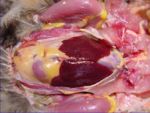Structure
- 2 lobes
- Dark brown coloured (except just after hatching where it is yellow)
- Right lobe larger than left lobe
- Ventral and caudal to the heart (as there is no diaphragm)
- CLosely associated to the proventriculus and spleen
- Thin capsule
- Indistinct lobation
- 2 bile ducts enter the distal duodenum, one from each lobe of the liver
- The duct from the right lobe is connected to the gallbladder
- Hepatic lobules indistinct (except near hilus) due to a lack of perilobular connective tissue
Function
- See liver funtion
Vasculature
Innervation
Lymphatics
- See liver lymphatics
Histology
- Polyhedral and angular cells
- Larger cells than in mammals
- Large, spherical nucleus
- Base of cell forms a wall of the sinusoid
- Cell apices communicate with the bile canaliculi
- Granular cytoplasm
- Liver cords form columns around the interlobular bile capillary. The cell arrangement is simpler than in mammals.
- Sinusoids anastamose freely
- Kupfer cells present
- Reticular fibres support the liver cords
- Elastic fibres in the capsule and vessels
Species Differences
- Pigeons and budgerigars lack a gall bladder
